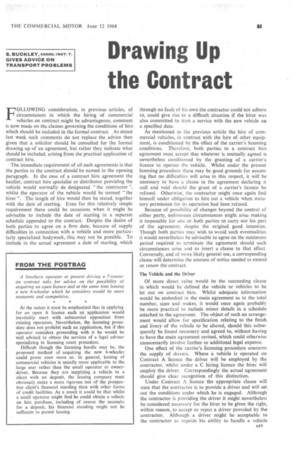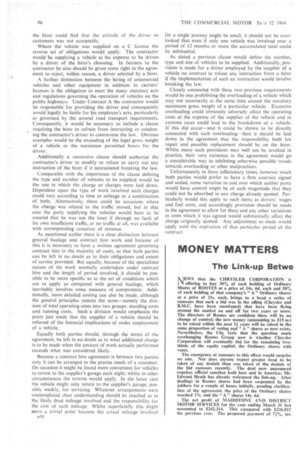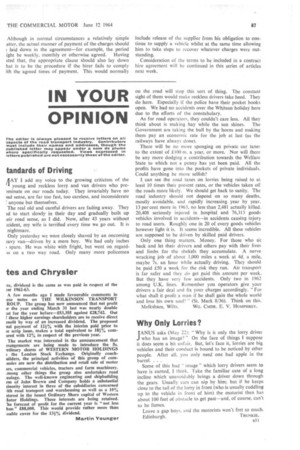Drawing Up the Contract
Page 87

Page 88

Page 89

If you've noticed an error in this article please click here to report it so we can fix it.
FOLLOWINCi consideration, in previous articles, of circumstances in which the hiring of commercial vehicles on contract might be advantageous, comment is now made on the clauses governing the conditions of hire which should be included in the formal contract. As stated last week such comments do not replace the advice then given that a solicitor should be consulted for the formal drawing up of an agreement, but rather they indicate what should be included, arising from the practical application of contract hire.
The immediate requirement of all such agreements is that the parties to the contract should be named in the opening paragraph. In the case of a contract hire agreement the haulier, contract hire specialist or distributor providing the vehicle would normally de designated "the contractor ", whilst the operator of the vehicle would be termed "the hirer ". The length of hire would then be stated, together with the date of starting. Even for this relatively simple requirement there could be occasions when it might be advisable to include the date of starting in a separate schedule appended to the contract. Despite the desire of both parties to agree on a firm date, because of supply difficulties in connection with a vehicle and more particularly specialized bodywork, this may not be possible. To include in the actual agreement a date of starting, which
through no fault of his own the contractor could not adhere to, could give rise to a difficult situation if the hirer was also committed to start a service with the new vehicle on a specified date.
As mentioned in the previous article the hire of commercial vehicles, in contrast with the hire of other equipment, is conditioned by the effect of the carrier's licensing conditions. Therefore, both parties to a contract hire agreement must accept that whatever is mutually agreed is nevertheless conditioned by the granting of a carrier's licence to operate the vehicle. Whilst under the present licensing procedure there may be good grounds for assuming that no difficulties will arise in this respect, it will be necessary to have a clause in the agreement declaring it null and void should the grant of a carrier's licence be refused. Otherwise, the contractor might once again find himself under obligation to hire out a vehicle when statutory permission for its operation had been refused.
Because of possibility of changes beyond the control of either party, unforeseen circumstances might arise making it impossible for one or both parties to carry out his part of the agreement, despite the original good intention. Though both parties may wish to avoid such eventualities it would nevertheless be advisable to agree on the minimum period required to terminate the agreement should such circumstances arise and to insert a clause to that effect. Conversely, and of more likely general use, a corresponding. clause will determine the amount of notice needed to extend or renew the contract.
The Vehicle and the Driver
Of more direct value would be the succeeding clause in which would be defined the vehicle or vehicles to be let out on contract hire. Whilst adequate information would be embodied in the main agreement as to the total number, sizes and makes, it would once again probably be more practical to include minor details in a schedule attached to the agreement. The object of such an arrangement would allow for specification relating to the finish and livery of the vehicle to be altered, should this subsequently be found necessary and agreed to, without having to have the main agreement revised, which could otherwise unnecessarily involve further or additional legal expense.
One effect of the carrier's licensing procedure concerns the supply of drivers. Where a vehicle is operated on Contract A licence the driver will be employed by the contractor, whilst under a C hiring licence the hirer will employ the driver. Correspondingly the actual agreement should give clear recognition of this distinction.
Under Contract A licence the appropriate clause will state that the contractor is to provide a driver and will set out the conditions under which he is engaged. Although the contractor is providing the driver it might nevertheless be considered necessary for the hirer to be given the right, within reason, to accept or reject a driver provided by the contractor. Although a driver might be acceptable to the contractor as regards his ability to handle a vehicle
the hirer could find that the attitude of the driver to customers was not acceptable.
Where the vehicle was supplied on a C licence the reverse set of obligations would apply. The contractor would be supplying a vehicle at his expense to be driven by a driver of the hirer's choosing. In fairness to the contractor he also should be given some right in the agreement to reject, within reason, a driver selected by a hirer.
A further distinction between the hiring of commercial vehicles and other equipment in addition to carriers' licences is the obligation to meet the many statutory acts and regulations governing the operation of vehicles on the public highways. Under Contract A the contractor would be responsible for providing the driver and consequently would legally be liable for his employee's acts, particularly as governed by the several road transport rbquirements. Consequently, it would be necessary to include a clause requiring the hirer to refrain from instructing or condoning the contractor's driver to contravene the law. Obvious examples would be the exceeding of the legal gross weight of a vehicle or the maximum permitted hours for the driver.
Additionally a successive clause should authorize the contractor's driver to modify or refuse to carry out any instruction of the hirer if it necessitated breaking the law.
Comparable with the importance of the clause defining the type and number of vehicles to be supplied would be the one in which the charge or charges were laid down. Dependent upon the type of work involved such charges could vary according to time or mileage or a combination of both. Alternatively, there could be occasions where the charge was related to the traffic moved, but in that case the party supplying the vehicles would have to be assured that he was not the loser if through no fault of his own insufficient traffic, or no traffic at ail, was available with corresponding cessation of revenue.
As mentioned earlier there is a clear distinction between general haulage and contract hire work and because of this it is necessary to have a written agreement governing contract hire in the majority of cases, so that both parties can be left in no doubt as to their obligations and extent of service provided. But equally, because of the specialized nature of the work normally undertaken under contract hire and the length of period involved, it should be possible to be more specific as to the set of conditions which are to apply as compared with general haulage, which inevitably involves some measure of compromise. Additionally, more detailed costing can also be made, although the general principles remain the same—namely the division of total operating costs into two groups: standing costs and running costs. Such a division would emphasize the point just made that the supplier of a vehicle should be relieved of the financial implications of under employment of a vehicle.
Equally both parties should, through the terms of the agreement, be left in no doubt as to what additional charge is to be made when the amount of work actually performed exceeds what was considered likely.
Because a contract hire agreement is between two parties only it can be arranged to the precise needs of a customer. On occasion it might be found more convenient for vehicles to return to the supplier's garage each night, whilst in other circumstances the reverse would apply. In the latter case the vehicle might only return to the supplier's garage, possibly weekly, for servicing. Whatever arrangements were contemplated clear understanding should be reached as to the likely dead mileage involved and the responsibility for the cost of such mileage, Whilst superficially this might seem ,a trivial point because the actual mileage involved aS0
f-Or a single journey might be small, it should not be overlooked that even if only one vehicle was involved over a period of 12 months or more the accumulated total could be substantial.
As stated a previous clause would define the number, type and size of vehicles to be supplied. Additionally, provision is made for a driver-employed by the supplier of a vehicle on Contract to refuse any instruction from a hirer if the implementation of such an instruction would involve breaking the law.
Closely connected with these two previous requirements would be one prohibiting the overloading of a vehicle which may not necessarily at the same time exceed the statutory maximum gross weight of a particular vehicle. Excessive overloading could obviously adversely affect the operating costs at the expense of the supplier of the vehicle and in extreme cases could lead to the breakdown of a vehicle. If this did occur—and it could be shown to be directly connected with such overloading—then it should be laid down in the agreement that the responsibility both for repair and possible replacement should be on the hirer. Whilst many such provisions may well not be invoked in practice, their very existence in the agreement would go a considerable way to inhibiting otherwise possible trends towards overloading or other malpractices.
Unfortunately in these inflationary times, however much both parties would prefer to have a firm contract signed and sealed, some variation in cost over which neither party would have control might be of such magnitude that they could not be absorbed in any charge already quoted. Particularly would this apply to such items as drivers' wages and fuel costs, and accordingly provision should be made in the agreement to allow for these and any other variations in costs which it was agreed would substantially affect the charge originally quoted, Any adjustment so made would apply until the expiration of that particular period of the contract. Although in normal circumstances a relatively simple atter, the actual manner of payment of the charges should ; laid down in the agreement—for example, the period ight be weekly, monthly or otherwise agreed. Having ited that, the appropriate clause should also lay down hat is to be the procedure if the hirer fails to comply ith the agreed times of payment. This would normally include release of the supplier from his obligation to continue to supply a vehicle whilst at the same time allowing him to take steps to recover whatever charges were outstanding.
Consideration of the terms to be included in a contract hire agreement will be continued in this series of articles next week.
































































































































